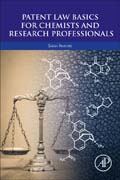
Patent Law Basics for Chemists and Research Professionals provides an accessible overview for chemists, research scientists, pharmaceutical researchers, R&D executives, and others working with the unique issues that those patenting chemical inventions face. Researchers must often work with patent professionals at the direction of their supervisors in order to procure patent protection for the inventions they have discovered and/or to determine whether the products they are developing would infringe on patents held by others. By providing chemists and research professionals with a better understanding of what information is most important to obtain the strongest possible patent protection, scientists can work with patent professionals more effectively, thereby enhancing the strength and value of patents with which they are involved. Beginning with the basics, this useful primer introduces the reader to patents, patents rights, and other types of intellectual property, such as trademarks and copyrights. A sample patent is dissected to explain its various parts and interpretation. The book discusses the types of inventions patented in the life sciences, chemical, and pharmaceutical technologies, and the basic legal requirements for obtaining a patent, along with common application mistakes. Delving deeper into what can be a mysterious process to the outsider, the book also explores relevant case law and typical patent litigation. Provides valuable information about patent law changes brought about by the 2011 America Invents Act (AIA)Demystifies the patent application process and highlights common, avoidable mistakesIncludes a handy glossary for quick reference, along with accessible explanations and summaries for the layperson INDICE: 1. Introduction to Patents 2. Parts of a Patent3. Major types of inventions that are patented in the chemical technologies4. When do you have a patentable invention? 5. Patenting inventions in the life sciences technologies 6. What goes on at the Patent Office? 7. When does someone qualify as an inventor on a patent? 8. Ownership of patents 9. Unique issues university scientists must deal with 10. America Invents Act 11. Patent Litigation 101 12. Overview13. Additional Patent Resources
- ISBN: 978-0-12-803548-1
- Editorial: Academic Press
- Encuadernacion: Rústica
- Páginas: 275
- Fecha Publicación: 01/03/2017
- Nº Volúmenes: 1
- Idioma: Inglés
